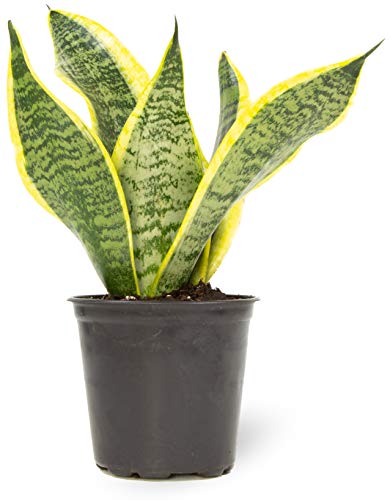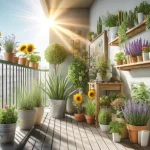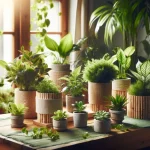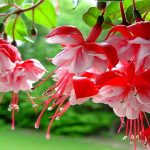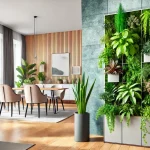This post may contain affiliate links. If you buy something from one of our links we may earn a commission. Thanks
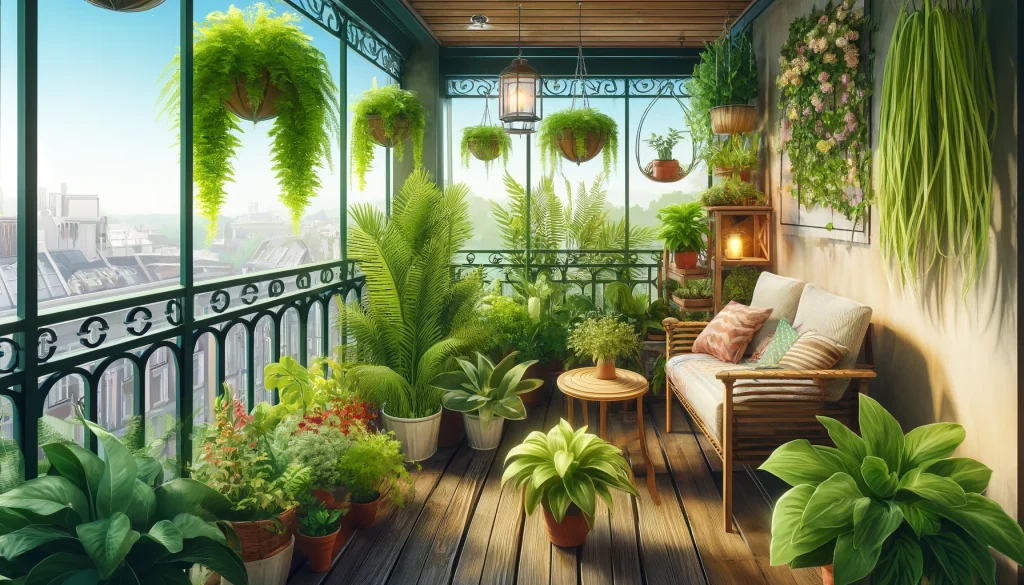
Discover the best shade-tolerant plants for balconies with limited sunlight to transform your space into a lush retreat!
Shade Tolerant Plants Key Takeaways:
- Best Shade-Tolerant Plants for Balconies include:
- Ferns, which thrive in low light.
- Begonias, are known for their colorful flowers.
- Hostas add lush greenery,
- Impatiens bloom beautifully without full sun.
- Caladiums and Heucheras offer striking leaves.
- Petunias and Fuchsia bring vibrant flowers.
- Vervain (Verbena) stands out with its cascading growth
- Lobelia, hydrangeas, and chrysanthemums are also excellent choices for shady balcony areas.
Best Shade-Tolerant Plants for Balconies With Limited Sunlight
Looking to green up your balcony but are stuck with shadows most of the day? Don’t sweat it, my fellow plant enthusiasts!
There’s a whole world of greenery that flourishes in the background. I’ve got the scoop on the best shade-tolerant plants for urban gardening on balconies with limited sunlight.
These leafy friends don’t just survive; they thrive in those cozy corners. So, let’s dive in and find the perfect plants to spruce up your shaded oasis!
Getting Started With Shade Loving Plants
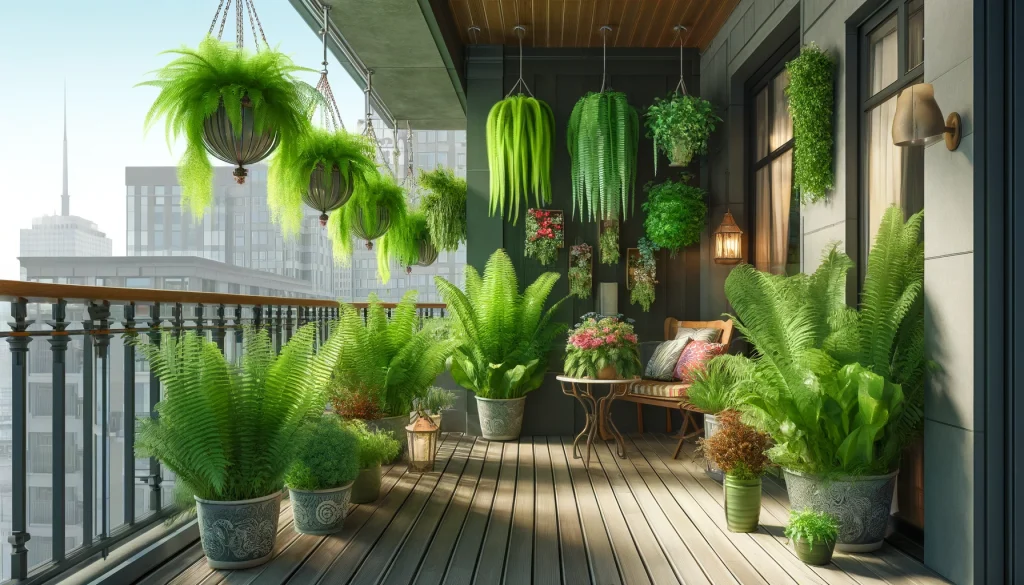
Creating a lush and vibrant balcony garden can be a challenge when you have limited sunlight.
However, with careful planning and the right plant choices, you can still enjoy a stunning green oasis in this space.
Before selecting plants for your balcony with little sun, there are certain factors to consider to ensure their growth and survival.
By assessing sunlight levels, choosing shade-tolerant plants, determining soil and watering needs, and managing temperature and humidity, you can set the stage for a successful balcony garden.
Small space gardening is entirely possible with proper planning and plant selection even if your patio or terrace is small.
Assessing Sunlight Levels:
It is crucial to evaluate the amount of sunlight your balcony receives throughout the day.
Observe and note the duration and intensity of sunlight, as this will help determine the types of plants that can thrive in your specific conditions.
Choosing Plants That Thrive in Shade:
Opt for plant varieties that are known for their ability to tolerate low light conditions.
Look for shade-loving plants that have adapted to thrive in environments with limited sunlight.
Determining Soil and Watering Needs:
Different plants have different soil and watering requirements. It is essential to choose potting soil that is well-draining and appropriate for the plants you select.
Be mindful of the watering needs of your chosen plants and create a watering schedule accordingly.
Managing Temperature and Humidity:
Balconies can be subject to temperature fluctuations and varying humidity levels.
Consider selecting plants that can tolerate these conditions and monitor temperature and humidity levels regularly to ensure the optimal growing environment for your plants.
By carefully considering these factors, you can make informed decisions when choosing the best plant options for your balcony with little sunlight.
Let’s explore some plant varieties that thrive in shade and are suitable for balcony gardens in such conditions.
Factors to Consider for Plants on Balconies with Little Sunlight
When it comes to selecting plants for balconies with limited sunlight, there are key factors to consider.
Let’s explore these important considerations that will help you create a thriving green oasis in the shade.
From assessing sunlight levels to choosing shade-tolerant plants, determining optimal soil and watering needs, and managing temperature and humidity, we’ll break down each aspect to ensure your balcony plants flourish in less sun-drenched environments.
So, let’s dig in and uncover the secrets to a vibrant and lush balcony garden in spite of the limited sunlight.
Assessing Sunlight Levels
| Assessing Sunlight Levels |
| 1. Determine the orientation of your balcony to understand the direction in which sunlight falls. East-facing balconies receive morning sunlight, while west-facing balconies receive afternoon sunlight. |
| 2. Observe the duration of sunlight exposure on your balcony. Use a timer or note the time when direct sunlight hits your balcony and when it disappears. |
| 3. Assess the intensity of sunlight on your balcony. Is the sunlight direct and intense, or is it shaded and filtered through trees or buildings? |
| 4. Use a sunlight meter or smartphone app to measure the light levels on your balcony. This will provide you with quantitative data to determine the amount of sunlight your plants will receive. |
| 5. Take into account seasonal variations in sunlight. The amount and intensity of sunlight on your balcony may change throughout the year due to factors like the position of the sun and the angle of sunlight. |
Choosing Plants That Thrive in Shade
When it comes to choosing plants that thrive in shade for your balcony with limited sunlight, there are several options available that can flourish in these conditions.
- Choosing Ferns: Ferns are a great choice for shady balconies as they can tolerate low light levels and thrive in humid environments. They come in various sizes and textures, adding a touch of elegance to your space.
- Opting for Begonias: Begonias are known for their vibrant flowers and attractive foliage. They can tolerate shade well and are available in many different varieties, including wax begonias and tuberous begonias.
- Consider Hostas: Hostas are shade-loving plants that are valued for their large, textured foliage. They come in a variety of colors and provide a lush, green backdrop to your balcony.
- Introducing Impatiens: Impatiens are colorful annual flowers that thrive in shaded areas. They come in a range of hues and can add a pop of color to your balcony display.
- Adding Caladiums: Caladiums are tropical plants with striking, multicolored leaves that can brighten up any shady corner. They prefer indirect light and are often grown as potted plants.
- Include Heucheras: Heucheras, also known as coral bells, are shade-loving perennials that offer attractive foliage in various colors, such as green, purple, and bronze. They can add texture and interest to your balcony garden.
By choosing plants that thrive in shade, you can create a beautiful and thriving balcony garden, even with limited sunlight.
Consider the specific conditions of your balcony, such as the amount of shade it receives and the humidity levels, to select the best plants for your space.
With careful selection and proper care, your balcony garden can become a lush and inviting oasis.
Determining Soil and Watering Needs
When it comes to determining soil and watering needs for plants on balconies with little sunlight, it is important to follow a few key steps.
First, assess the drainage capacity of the soil. Check if the soil on your balcony drains well as poor drainage can lead to waterlogged roots and plant diseases.
To test this, water a small section of the balcony and observe how long it takes for the water to drain.
Next, choose the right potting mix. Use a high-quality, well-draining potting mix that is specifically formulated for container gardening.
A mix of coco coir and perlite is an excellent environmentally sustainable choice.
Avoid heavy soils that can retain too much moisture.
Water plants appropriately based on their individual needs and the weather conditions.
Allow the top inch of soil to dry out before watering again. Deep watering less frequently is generally better than frequent shallow watering.
Regularly monitor moisture levels in the soil to prevent overwatering or underwatering.
Stick your finger about an inch into the soil to feel for moisture. If it feels dry, it’s time to water.
Consider the size and material of the pots. Larger pots retain more moisture, so adjust your watering schedule accordingly.
Choose pots made of materials that allow for proper drainage, such as terracotta or plastic with drainage holes.
Another helpful tip is to use mulch. Applying a layer of organic mulch on top of the soil can help retain moisture and prevent weed growth.
Additionally, mulch helps maintain a stable soil temperature.
Lastly, observe the health of your plants. Pay attention to any signs of wilting, yellowing leaves, or stunted growth, as these can indicate overwatering or underwatering. Adjust your watering practices accordingly.
By following these steps, you can ensure that your plants on balconies with little sunlight have the right soil and receive adequate watering for their health and growth.
Managing Temperature and Humidity
When it comes to managing temperature and humidity for plants on balconies with little sunlight, there are several steps you can take to create a favorable environment:
• Choose plants that can tolerate lower temperatures and higher humidity levels. These plants are often referred to as shade-loving plants and include varieties such as ferns, hostas, and impatiens.
• Monitor the temperature and humidity levels regularly using a thermometer and hygrometer.
Aim to keep the temperature between 60-75 degrees Fahrenheit (15-24 degrees Celsius) and the humidity levels between 40-60%.
• Provide proper ventilation to regulate temperature and humidity. This can be achieved by opening windows, using fans, or placing the plants in a location where they can receive a gentle breeze.
• Use a humidifier or misting spray to increase humidity levels if necessary.
This is especially important during dry seasons or in areas with low humidity.
• Avoid placing the plants near heat sources or drafts, as these can cause temperature fluctuations and affect humidity levels.
• Water the plants appropriately to maintain a balanced moisture level.
Be mindful not to overwater, as this can lead to excess humidity and potential fungal growth. Conversely, underwatering can result in dry conditions.
• Add a layer of mulch to the soil to regulate temperature and retain moisture.
This will help create a more stable environment for the plants.
• Consider using a humidity tray or pebble tray underneath the plant containers.
This involves placing a tray filled with water and pebbles beneath the pots to increase humidity levels around the plants.
• Regularly monitor and adjust temperature and humidity levels based on the specific needs of your plants.
• Some plants may require slightly higher or lower temperatures and humidity, so it’s important to research the specific requirements of each plant you are growing.
By following these steps, you can effectively manage temperature and humidity of your plants on balconies with little sunlight, creating a suitable environment for their growth and well-being.
Best Plant Options for Balconies with Little Sunlight
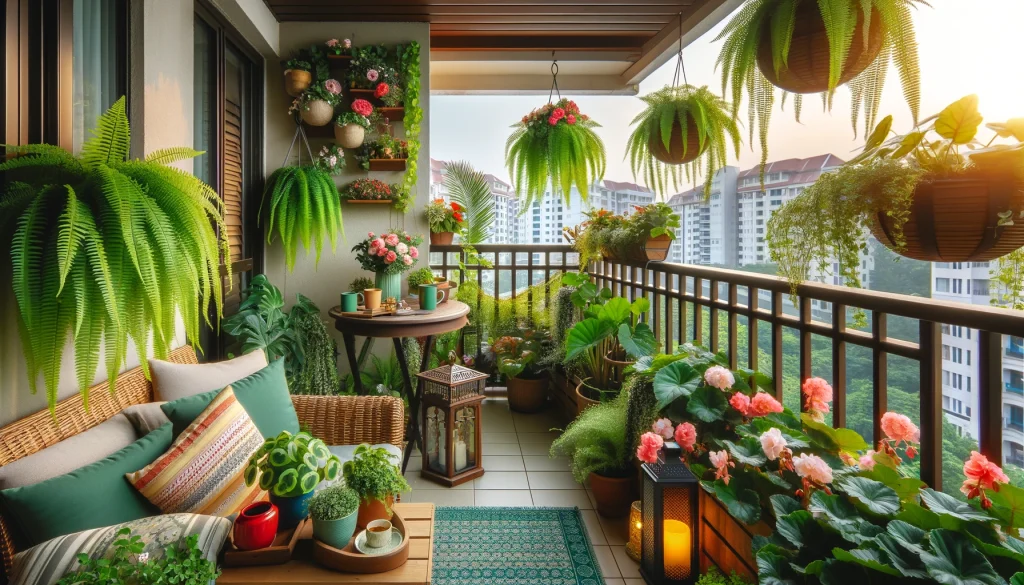
When it comes to choosing the best plants for balconies with little sunlight, there are several options that can thrive in such conditions.
Here is a list of the best plant options for balconies with little sunlight:
- Ferns: Ferns are an excellent choice for balconies with little sunlight. They can tolerate low light and are known for their lush, green foliage.
- Snake Plant: Snake plants, also known as Sansevieria, are perfect for low-light environments. They require minimal care and can add a touch of elegance to your balcony.
- Pothos: Pothos plants are well-suited for balconies with little sunlight. They can tolerate a range of lighting conditions, including low light, and have beautiful trailing vines.
- ZZ Plant: The ZZ plant, or Zamioculcas zamiifolia, is an excellent option for low-light balconies. It has dark, glossy leaves and can thrive in almost any lighting condition.
- Peace Lily: Peace lilies are popular indoor plants that can also thrive on balconies with limited sunlight. They have beautiful white flowers and can help improve air quality.
Remember to consider the specific lighting conditions of your balcony and choose plants that are suitable for low-light environments.
Regular watering and proper drainage are essential for the health and growth of these plants.
Tips for Success in Balcony Gardening with Limited Sunlight
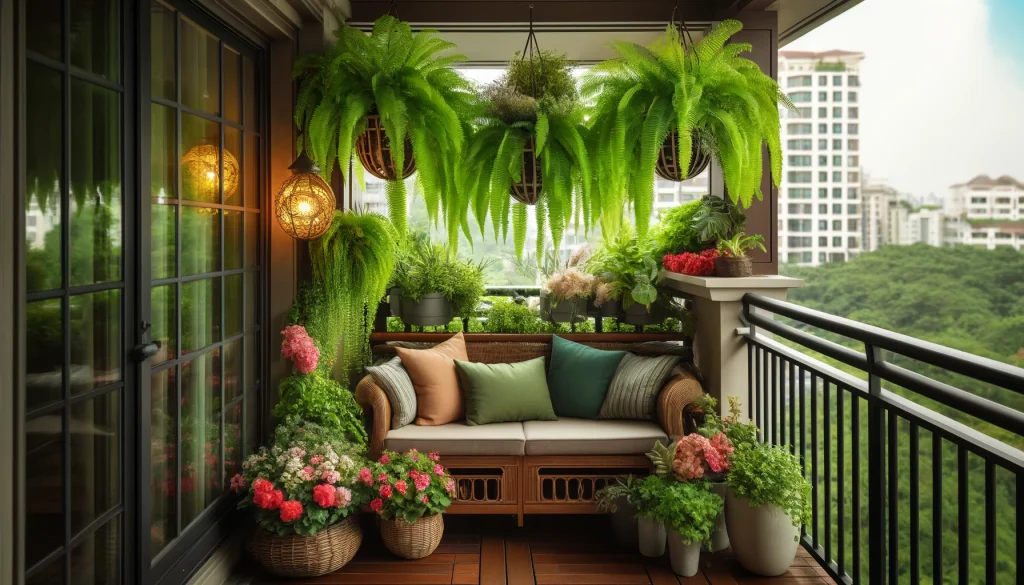
Balcony gardening can be a challenging task, especially if your balcony receives limited sunlight.
With the right tips and techniques, you can still have a successful garden.
Here are some tips to help you thrive in balcony gardening with limited sunlight:
- Choose the right plants: Opt for plants that can thrive in low-light conditions. Some examples include ferns, begonias, impatiens, and hostas. These plants are known for their ability to tolerate shade and require less sunlight to grow.
- Utilize reflective surfaces: Place reflective surfaces, such as mirrors or white walls, around your balcony to maximize the available sunlight. This will help redirect and amplify the natural light, providing more brightness to your plants.
- Rotate your plants: If your balcony receives some sunlight at different times of the day, rotate your plants accordingly. This will ensure that each plant receives its fair share of sunlight throughout the day.
- Consider artificial lighting: If your balcony doesn’t receive any natural sunlight, consider using artificial lighting. LED grow lights are effective in providing the necessary light energy for plant growth. Position the lights strategically to cover all your plants evenly.
- Water properly: Be mindful of the watering needs of your plants. Most shade-tolerant plants don’t require as much water as those in full sunlight. Overwatering can lead to root rot, so ensure the soil is well-drained and allow it to dry out slightly between waterings.
- Fertilize appropriately: Feed your plants with a balanced, slow-release fertilizer to provide them with essential nutrients. Avoid over-fertilizing, as this can damage your plants. Follow the instructions on the fertilizer packaging for the correct application rate.
By following these tips for success in balcony gardening with limited sunlight, you can create a flourishing balcony garden.
Remember to adapt your gardening routine and care practices to the specific needs of your plants.
With patience and proper care, you can enjoy a beautiful and thriving garden on your balcony, regardless of how much sunlight it receives.
Frequently Asked Questions
1. What are some plants suitable for balconies with little sun?
For balconies with little sun, you can grow shade-loving plants such as hostas, cyclamen coum, ladys mantle, and Japanese maples like Acer palmatum.
These plants thrive in lower light conditions and are perfect for creating a colorful little garden in the shade zone of your balcony.
2. Can I grow herbs on a balcony with limited sunlight?
Absolutely! Even in limited sunlight, you can still have an herb garden on your balcony.
Opt for herbs like mint, chives, parsley, and dill, which can tolerate shade and still grow beautifully.
These herbs add fresh aroma and flavor to your culinary adventures.
3. What houseplants can thrive in a balcony with little sun?
For a balcony with little sun, consider houseplants like spider plants, peace lilies, and pothos.
These plants do well in lower light conditions and can bring a touch of greenery to your balcony.
Just make sure to provide them with some shelter from direct sunlight.
4. What are some flowering plants that can bloom on a shady balcony?
If your balcony doesn’t receive much sunlight, you can still enjoy colorful flowers.
Try growing impatiens, begonias, nicotianas, and farmers hydrangeas. These plants don’t need a lot of sun to bloom and will add beauty to your shady balcony.
5. Can I have a balcony garden with only limited sunlight?
Definitely! With the right selection of plants, you can create a beautiful balcony garden even with limited sunlight.
Choose shade-loving plants, herbs, and houseplants that thrive in lower light conditions.
Be creative with different levels of sunlight and make the most of your balcony space.
6. Can I grow vegetables on a balcony with little sun?
While most vegetables require ample sunlight, there are a few that can tolerate limited sun.
Consider growing spring onions, runner beans, and tender ferns on your balcony with little sun.
These vegetables can still produce a bountiful harvest even in lower light conditions.
Visit my Amazon Influencer Page for videos and gardening products Grow Your Own Garden









